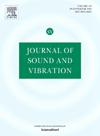Target-free vision method for planar displacement measurement of structures subjected to out-of-plane movement by UAV
IF 4.3
2区 工程技术
Q1 ACOUSTICS
引用次数: 0
Abstract
In the field of structural health monitoring, one of the essential tasks is to measure dynamic responses such as vibration displacement. With the recent advancement in computer vision, cameras are developed as alternative tools to traditional displacement sensors. Unmanned aerial vehicles (UAVs) offer mobility and can handle complex real-world situations. However, limitations of using UAVs, particularly self-motions, have hindered the accuracy in vibration displacement measurements. This paper proposes a target-free vision-based approach for measuring dynamic displacement responses using UAV. A series of videos of a beam subjected to planar motions are captured using a UAV. Stationary features on the background and target features on the structure are detected using features from accelerated segment test with adaptive threshold strategy and tracked using the Kanade–Lucas–Tomasi. UAV self-motions are estimated using motion-only bundle adjustment. Dynamic displacement responses of the structure are computed based on the displacements of target features and UAV self-motions. Results of the displacement responses and identified natural frequencies with different planar motion types and shooting angles are obtained. They are compared with those obtained by linear variable differential transducers, which demonstrates the accuracy of the proposed method for vibration displacement response measurement.
求助全文
约1分钟内获得全文
求助全文
来源期刊

Journal of Sound and Vibration
工程技术-工程:机械
CiteScore
9.10
自引率
10.60%
发文量
551
审稿时长
69 days
期刊介绍:
The Journal of Sound and Vibration (JSV) is an independent journal devoted to the prompt publication of original papers, both theoretical and experimental, that provide new information on any aspect of sound or vibration. There is an emphasis on fundamental work that has potential for practical application.
JSV was founded and operates on the premise that the subject of sound and vibration requires a journal that publishes papers of a high technical standard across the various subdisciplines, thus facilitating awareness of techniques and discoveries in one area that may be applicable in others.
 求助内容:
求助内容: 应助结果提醒方式:
应助结果提醒方式:


